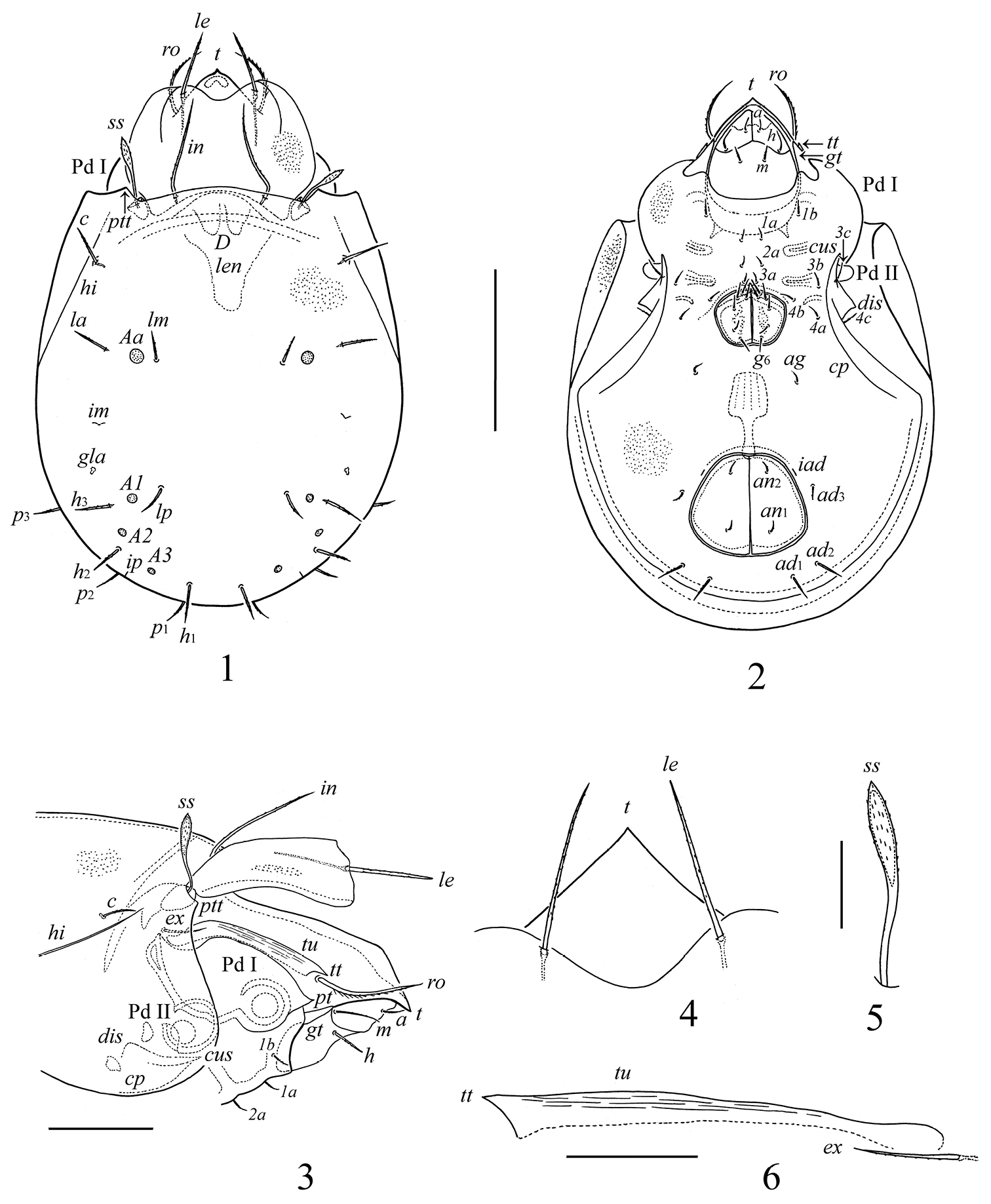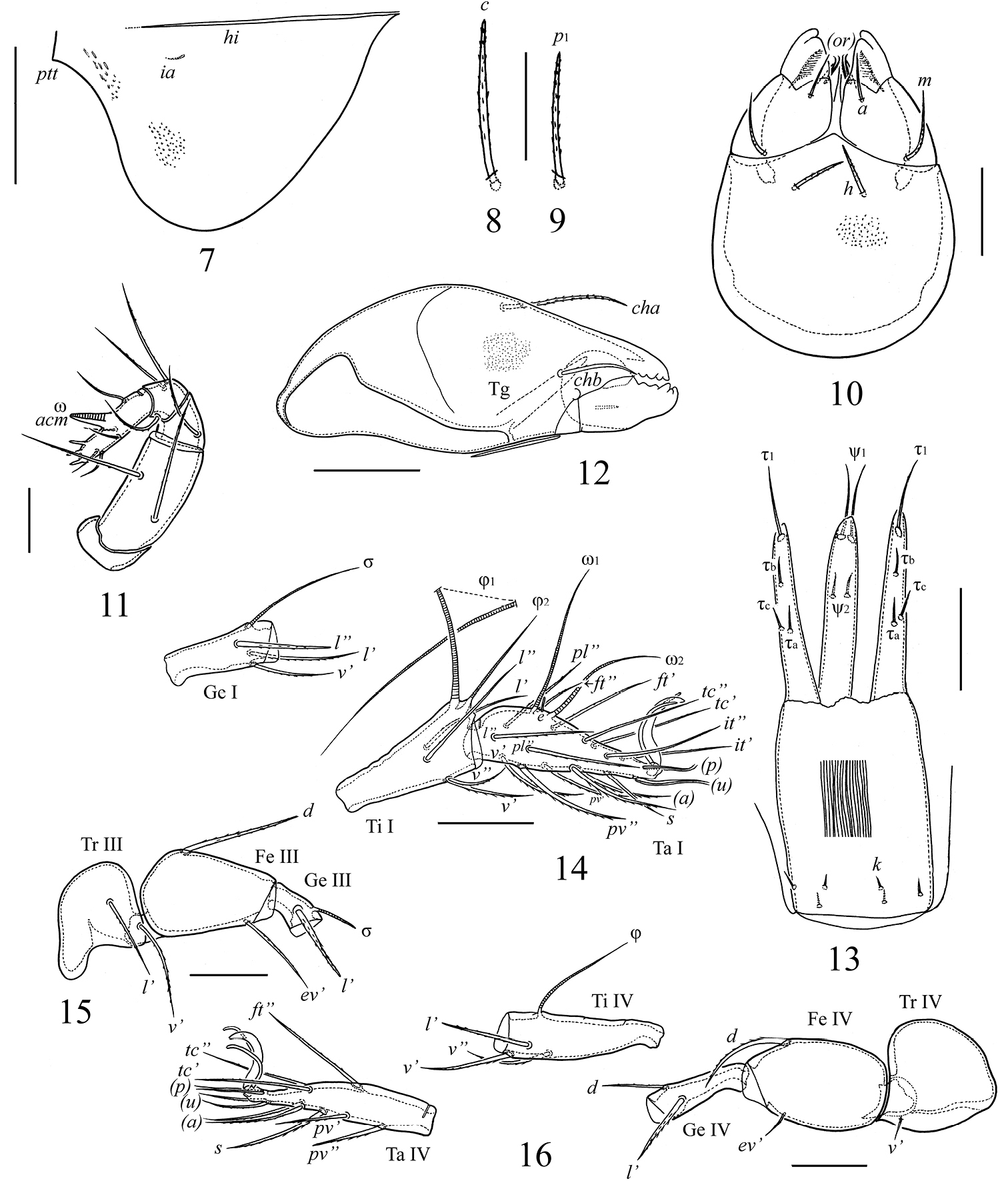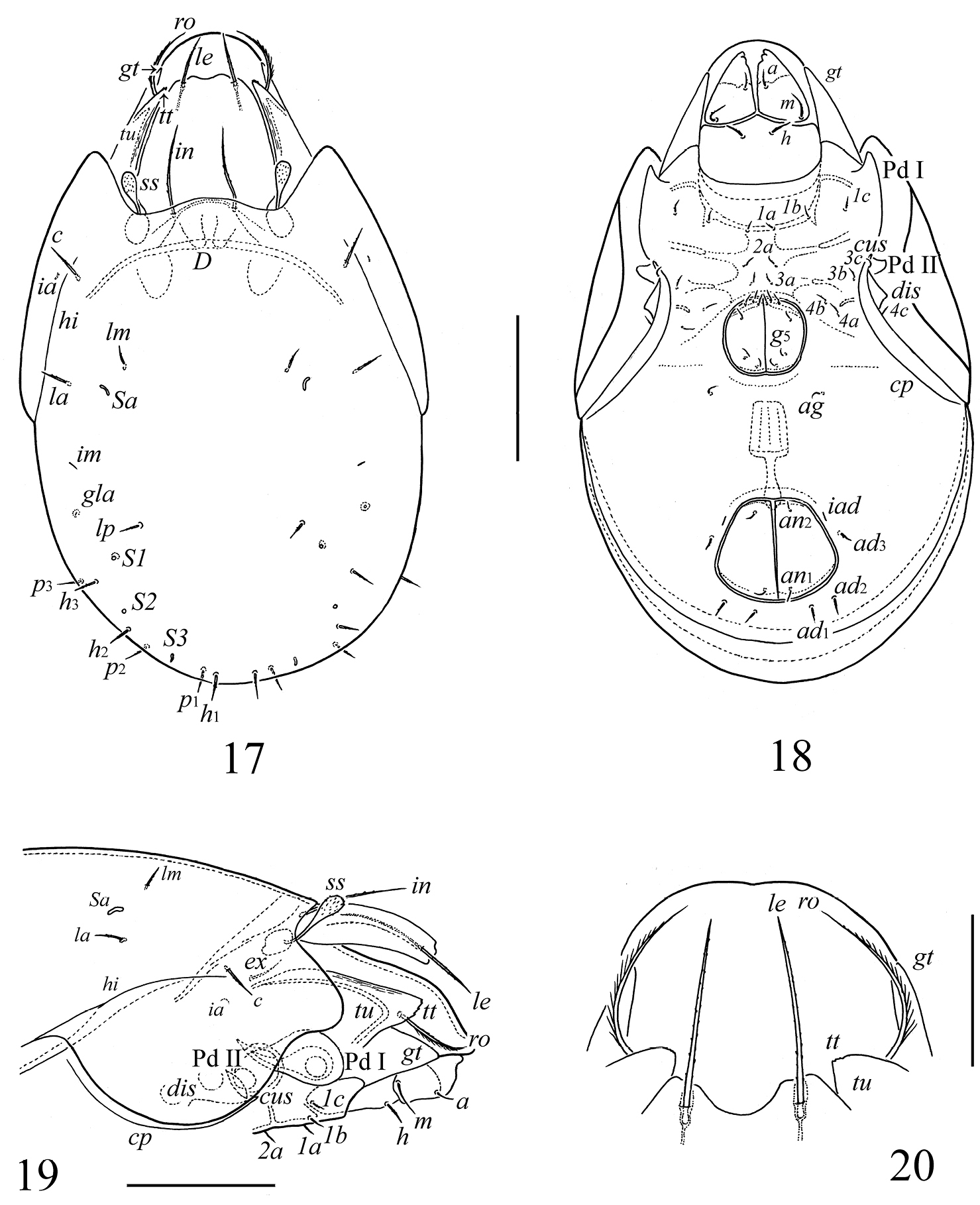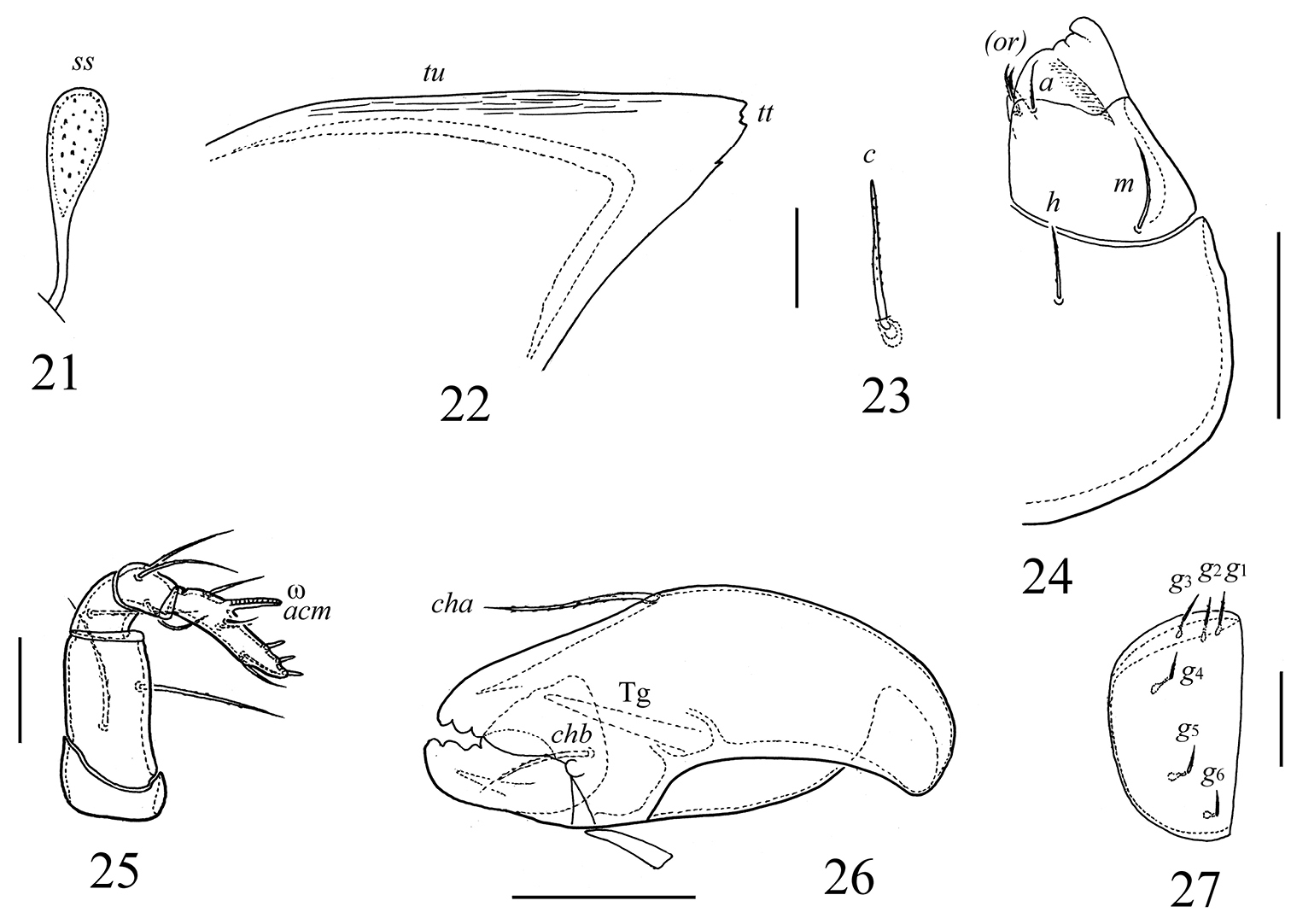






(C) 2013 Sergey G. Ermilov. This is an open access article distributed under the terms of the Creative Commons Attribution License 3.0 (CC-BY), which permits unrestricted use, distribution, and reproduction in any medium, provided the original author and source are credited.
For reference, use of the paginated PDF or printed version of this article is recommended.
Citation: Ermilov SG, Martens J, Tolstikov AV (2013) New species of oribatid mites of the genera Lepidozetes and Scutozetes (Acari, Oribatida, Tegoribatidae) from Nepal. ZooKeys 339: 55–65. doi: 10.3897/zookeys.339.6199
Two new species of oribatid mites, Lepidozetes acutirostrum sp. n. and Scutozetes clavatosensillus sp. n., are described from Nepal. The genera Lepidozetes and Scutozetes are recorded for the first time for the Oriental region. The identification keys to the known species of these genera are provided.
Oribatida, new species, description, Lepidozetes, Scutozetes, key, Nepal
In the course of taxonomic identification of Nepalese oribatid mites
Lepidozetes is a small genus that was proposed by
Scutozetes is a small genus that was proposed by
The identification keys to the known species of Lepidozetes and Scutozetes are provided below.
Specimens of Lepidozetes acutirostrum sp. n. (holotype: female; six paratypes: four females, two males) and Scutozetes clavatosensillus sp. n. (holotype: female; five paratypes: three females, two males) were collected by J. Martens and A. Ausobsky from Nepal: Mustang District, Purano Marpha above the village of Marpha, eastern Dhaulagiri massif, 3200–3600 m a.s.l., forest (prevailed Pinus wallichiana, Cupressus torulosa, Abies spectabilis) slightly north of the Himalayan main range, soil litter, 22.IV.1980.
All specimens were studied in lactic acid, mounted in temporary cavity slides for the duration of the study, and then stored in 70% ethanol in vials. Body measurements are presented in micrometers. The body length was measured in lateral view, from the tip of the rostrum to the posterior edge of the ventral plate. Notogastral width refers to the maximum width in dorsal aspect. Lengths of body setae were measured in lateral aspect. Formulae for leg setation are given in parentheses according to the sequence of trochanter–femur–genu–tibia–tarsus (famulus included). Formulae for leg solenidia are given in square brackets according to the sequence of genu–tibia–tarsus. Terminology used in this paper mostly follows that of
http://zoobank.org/A2C12F54-D6D3-4624-9C5F-B944E4C1F09F
http://species-id.net/wiki/Lepidozetes_acutirostrum
Figs 1–16Body size 647–697 × 431–481. Body surface microfoveolate. Rostrum pointed. Anterior margin of lamellae concave medially. Interlamellar setae longer than rostral and lamellar setae. Sensilli with lanceolate head. Tutoria with one strong tooth. Notogastral setae of medium size, weakly thickened, barbed. Pedotecta I pointed anteriorly. Adanal setae ad1, ad2 longer than other anogenital setae.
Measurements. Body length 697 (holotype: female), 647–697 (six paratypes: four females and two males); body width 481 (holotype), 431–481 (six paratypes).
Integument. Body color brown. Body surface distinctly microfoveolate; foveolae rounded (diameter up to 1) or elongated. Dorsal sides of lamellae with longitudinal striae.
Prodorsum. Rostrum pointed (t). Lamellae long and broad, covering the prodorsum completely, except rostrum and parts of pedotecta I (Pd I). Anterior margin of lamellae concave medially. Rostral setae (ro, 94–106) setiform, ciliate, directed anterio-mediad, inserted laterally on prodorsum. Lamellar setae (le, 77–86) thickened, straight, barbed, directed forward, inserted dorso-anteriorly on lamellae. Interlamellar setae (in, 131–130) setiform, barbed, directed upwards and forwards, inserted on posterior part of lamellae; basal parts of these setae covered by the anterior margin of notogaster. Sensilli (ss, 82–94) with long stalk and elongate, lanceolate, barbed head. Tutoria (tu) long, of medium width, with one strong tooth anteriorly. Exobothridial setae (ex, 32–94) setiform, thin, slightly barbed, inserted posteriorly to tutoria.
Notogaster. Pteromorphs broadly rounded laterally. Anterior margins of pteromorphs with pointed tooth (ptt). Dorsophragmata (D) located close to each other. Postero-median part of hinges (hi) distinct, anterior part unvisible. Lenticulus (len) present, triangular, with amorphic borders. Four pairs of porose areas rounded: Aa (16–20), A1 (12–16), A2 and A3 (both pairs, 8–12). Ten pairs of notogastral setae weakly thickened, barbed: posterior setae p1, p2, p3 (32–41) shorter than other setae (53–61). Lyrifissures ia, im, ip, ih and ips and opisthonotal gland openings (gla) located typically for the genus.
Gnathosoma. Subcapitulum longer than wide (151 × 110). Subcapitular setae h (28–32) thickened, straight, barbed; a (18–21) and m (41–45) thinner, slightly barbed. Two pairs of adoral setae (or1, or2, 12–14) setiform, hook-like distally, barbed. Palps (length 90–94) with setation 0–2–1–3–9(+ω). Solenidion weakly thickened, straight, blunt-ended, attached with eupathidium (acm). Chelicerae (length 151) with two barbed setae; cha (45–49) longer than chb (28–32). Trägårdh’s organ (Tg) long, conical.
Lateral podosomal and epimeral regions. Genal teeth (gt) narrowly triangular. Pedotecta I large, pointed (pt) anteriorly. Pedotecta II (Pd II) small, scale-like. Apodemes 1, 2, 3 and sejugal distinctly developed, not fused medially. Epimeral setal formula 2–1–3–3; setae (16–24) setiform, slightly barbed. Setae 1c and their alveoli absent. Custodia (cus) with thin, free, blunted tips, directed anteriorly to the pedotecta II. Discidia (dis) pointed. Circumpedal carinae (cp) distinct.
Anogenital region. Six pairs of genital (g1–g6, 20), one pair of aggenital (ag, 20), two pairs of anal (an1, an2, 24) and three pairs of adanal (ad1, ad2, 36–41; ad3, 28–32) setae setiform, barbed. Lyrifissures iad located in paraanal position. Ovipositor elongate, narrow (192 × 61); length of lobes 86, length of cylindrical distal part 106. Lobes with 12 thin, smooth setae: ψ1 ≈ τ1 (36) longer thanψ2 ≈ τa ≈ τb ≈τc (16). Coronal setae k simple, short (8).
Legs. Medial claw thicker than two lateral claws; all smooth. Generally, morphology of leg segments, setae and solenidia typical for the genus (
Leg setation and solenidia of adult Lepidozetes acutirostrum sp. n. (same data for Scutozetes clavatosensillus sp. n.).
| Leg | Trochanter | Femur | Genu | Tibia | Tarsus |
|---|---|---|---|---|---|
| I | v’ | d, (l), v’’, bv’’ | (l), v’, σ | (l), (v), φ1, φ2 | (ft), (tc), (it), (p), (u), (a), s, (pv), v’, (pl), l’’, e, ω1, ω2 |
| II | v’ | d, (l), v’’, bv’’ | (l), v’, σ | (l), (v), φ | (ft), (tc), (it), (p), (u), (a), s, (pv), ω1, ω2 |
| III | l’, v’ | d, ev’ | l’, σ | l’, (v), φ | (ft), (tc), (it), (p), (u), (a), s, (pv) |
| IV | v’ | d, ev’ | d, l’ | l’, (v), φ | ft’’, (tc), (p), (u), (a), s, (pv) |
Roman letters refer to normal setae (e to famulus), Greek letters to solenidia. Single prime (’) marks setae on anterior and double prime (’’) setae on posterior side of the given leg segment. Parentheses refer to a pseudosymmetrical pair of setae.
Lepidozetes acutirostrum sp. n., adult: 1 dorsal view 2 ventral view (legs not illustrated) 3 anterior part of body, lateral view (legs not illustrated)4 rostrum, anterior margin of lamellae, lamellar setae, dorso-anterior view 5 sensillus 6 tutorium and exobothridial seta. Scale bar (1, 2) 200 μm, (3) 100 μm, (4–6) 40 μm.
Lepidozetes acutirostrum sp. n., adult: 7 pteromorph, lateral view 8 notogastral seta c 9 notogastral seta p110 subcapitulum, ventral view 11 palp 12 chelicera 13 ovipositor 14 genu (Ge), tibia (Ti) and tarsus (Ta) of leg I, right, antiaxial view 15 trochanter (Tr), femur (Fe) and genu of leg III, left, antiaxial view 16 leg IV, right, antiaxial view. Scale bar (7) 100 μm, (8–10, 12, 14–16) 40 μm, (11) 20 μm, (13) 50 μm.
The holotype and one paratype are deposited in the collection of the Senckenberg Institution, Frankfurt, Germany; two paratypes are deposited in the collection of the Siberian Zoological Museum, Novosibirsk, Russia; three paratypes are deposited in the collection of the Tyumen State University Museum of Zoology, Tyumen, Russia.
The specific name “acutirostrum” refers to the pointed rostrum.
Lepidozetes acutirostrum sp. n. can be distinguished from all known species of the genus Lepidozetes using the key, which is presented below.
| 1 | Sensilli clavate, with head rounded distally; interlamellar setae clearly shorter than sensilli | 2 |
| – | Sensilli lanceolate, with head pointed distally or disk-like; interlamellar setae clearly longer than sensilli | 3 |
| 2 | Lamellae rounded anteriorly; leg tarsi with three claws; larger body size: 373–442 × 248–391 | Lepidozetes singularis Berlese, 1910 (=Lepidozetes conjunctus Schweizer, 1922; =Lepidozetes chernovi Ryabinin, 1974) (see |
| – | Lamellae concave anteriorly; leg tarsi with one claw; smaller body size: 300 × 229 | Lepidozetes trifolius Fujikawa, 1972 (see |
| 3 | Lamellae rounded anteriorly; sensilli with disk-like head; body size: 400 × 300 | Lepidozetes latipilosus Hammer, 1952 (see |
| – | Lamellae concave anteriorly; sensilli with lanceolate head | 4 |
| 4 | Rostrum pointed; larger body size: 647–697 × 431–481 | Lepidozetes acutirostrum sp. n. (Distribution: northern Nepal) |
| – | Rostrum rounded; smaller body size: 500–568 × 348–424 | Lepidozetes dashidorzsi Balogh et Mahunka, 1965 (see |
http://zoobank.org/1D0CFEF9-4751-4A75-A5C5-0E55D418468A
http://species-id.net/wiki/Scutozetes_clavatosensillus
Figs 17–27Body size 415–448 × 265–273. Rostrum broadly rounded. Lamellae not covering rostrum and lateral sides of prodorsum. Anterior margin of lamellae weakly concave medially. Interlamellar setae longer than rostral and lamellar setae. Sensilli clavate. Tutoria triangular distally, with two to five small teeth anteriorly. Anterior margins of pteromorphs triangular. Notogastral setae of medium size, weakly thickened, barbed. Genal teeth broadly triangular. Adanal setae ad1, ad2 longer than other anogenital setae.
Measurements. Body length 431 (holotype: female), 415–448 (five paratypes: three females and two males); body width 265 (holotype), 265–273 (five paratypes).
Integument. Body color light brown. Body surface microfoveolate (diameter of foveolae up to 1), but visible only under high magnification (× 1000) in dissected specimens. Dorsal sides of lamellae with longitudinal striae.
Prodorsum. Rostrum broadly rounded. Lamellae of medium size, not covering rostrum and lateral sides of prodorsum. Anterior margin of lamellae weakly concave medially. Rostral setae (57–65) setiform, ciliate, directed anterio-mediad, inserted laterally on prodorsum; their basal parts covered by the tutoria. Lamellar setae (41–49) straight, slightly barbed, directed forward, inserted dorso-anteriorly on lamellae. Interlamellar setae (73–82) setiform, slightly barbed, directed upwards and forwards, inserted on posterior part of lamellae; basal parts of these setae covered by the anterior margin of notogaster. Sensilli (45–53) clavate, with long stalk and oval head rounded or weakly truncated distally. Tutoria long, of medium width, triangular distally, with two to five small teeth anteriorly. Exobothridial setae (24) setiform, thin, slightly barbed, inserted dorso-posteriorly to tutoria.
Notogaster. Pteromorphs concave laterally. Anterior margins of pteromorphs triangular, longer than length of sensilli. Dorsophragmata located close to each other. Postero-median part of hinges distinct, anterior part unvisible. Lenticulus indistinctive. Four pairs of sacculli (Sa, S1, S2, S3) developed. Ten pairs of notogastral setae weakly thickened, barbed: setae c and la (both 28–32) longer than other setae (16–24). Lyrifissures ia, im, ip, ih and ips and opisthonotal gland openings located typically for the genus.
Gnathosoma. Subcapitulum longer than wide (110–114 × 86–90). Subcapitular setae h (16–20) thickened, straight, barbed; a (12–16) and m (24–28) little thinner, slightly barbed. Two pairs of adoral setae (10–12) setiform, hook-like distally, barbed. Palps (length 69–77) with setation 0–2–1–3–9(+ω). Solenidion weakly thickened, straight, blunt-ended, attached with eupathidium. Chelicerae (length 114) with two barbed setae; cha (36) longer than chb (24). Trägårdh’s organ long, conical.
Lateral podosomal and epimeral regions. Genal teeth broadly triangular. Pedotecta I of medium size, rounded anteriorly. Pedotecta II small, scale-like. Apodemes 1, 2, 3 and sejugal distinctly developed, not fused medially. Epimeral setal formula 3–1–3–3; setae (10–12) setiform, slightly barbed. Custodia with thin, free, blunted tips, directed anteriorly to the pedotecta II. Discidia pointed. Circumpedal carinae distinct.
Anogenital region. Six pairs of genital (8–12), one pair of aggenital (8–12), two pairs of anal (8–12) and three pairs of adanal (ad1, ad2, 14–16; ad3, 10–12) setae setiform, barbed. Lyrifissures iad located in paraanal position.
Legs. Similar to Lepidozetes acutirostrum sp. n.
Scutozetes clavatosensillus sp. n., adult: 17 dorsal view 18 ventral view (legs not illustrated) 19 anterior part of body, lateral view (legs not illustrated)20 rostrum, anterior margin of lamellae and tutoria, rostral and lamellar setae, dorso-anterior view. Scale bar (17–19) 100 μm, (20) 40 μm.
Scutozetes clavatosensillus sp. n., adult: 21 sensillus 22 tutorium 23 notogastral seta c 24 left half ofsubcapitulum, ventral view 25 palp 26 chelicera 27 right genital plate. Scale bar (21–23, 25, 27) 20 μm, (24, 26) 40 μm.
The holotype and one paratype are deposited in the collection of the Senckenberg Institution, Frankfurt, Germany; two paratypes are deposited in the collection of the Siberian Zoological Museum, Novosibirsk, Russia; two paratypes are deposited in the collection of the Tyumen State University Museum of Zoology, Tyumen, Russia.
The specific name “clavatosensillus” refers to the clavate sensilli.
Scutozetes clavatosensillus sp. n. can be distinguished from all known species of the genus Scutozetes by the key, which is presented below.
| 1 | Sensilli lanceolate, with head pointed distally; anterior margins of pteromorphs slightly projecting forward; body size: 437–484 × 320–390 | Scutozetes lanceolatus Hammer, 1952 (see |
| – | Sensilli clavate, with head rounded distally; anterior margins of pteromorphs strongly projecting forward, triangular-form | 2 |
| 2 | Lamellae large, covering lateral side of prodorsum, broadly rounded anteriorly; interlamellar setae reach the insertions of lamellar setae; body length: 420 | Scutozetes ovalis (Hammer, 1977) (see |
| – | Lamellae of medium size, not covering lateral side of prodorsum, concave anteriorly; interlamellar setae do not reach the insertions of lamellar setae; body size: 415–448 × 265–273 | Scutozetes clavatosensillus sp. n. (Distribution: North Nepal) |
We cordially thank Prof. Dr. Badamdorj Bayartogtokh (National University of Mongolia, Ulaanbaatar, Mongolia) for valuable comments, Dr. Umukusum Shtanchaeva and Prof. Dr. Luis Subías (Universidad Complutense de Madrid, Madrid, Spain) for consultations, and Dr. JenőKontschán (Hungarian National History Museum, Hungary) for help with studying the paratype of Lepidozetes dashidorzsi Balogh et Mahunka, 1965. Also, J. Martens thanks A. Ausobsky for helpful companionship during the 1980 Nepal expedition, as well as the Feldbausch Foundation and the Wagner Foundation at Fachbereich Biologie of Mainz University for several annual grants over the years to carry out field work in Asia.
1 Results of the Himalaya Expeditions of Dr. Jochen Martens.
2



